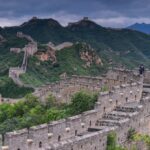Advance Booking
To visit the Palace Museum, you need to book tickets in advance through the WeChat mini-program “The Palace Museum” (closed on Mondays). The booking opens seven days in advance, so make sure to “grab” your tickets early!
Selfie sticks longer than 1.3 meters are not allowed inside.
Tickets
Tickets cost 60 yuan during the peak season and 40 yuan during the off-season. Seniors enjoy a 50% discount, and there is no free admission.
Transportation Tips
- During the off-season or if you want to see Tiananmen, it’s best to take subway line 1 and get off at Tiananmen East Station. Pass through the Tiananmen Gate Tower, follow the central axis to the Meridian Gate (Wumen), and enter the Palace Museum. (If you want to visit the Tiananmen Gate Tower, you must make a separate reservation in advance.)
- Taking a taxi is not recommended. I tried, but basically no drivers accepted the order, and even if they did, they canceled it later. It’s likely due to severe traffic congestion in that direction, and there are strict restrictions on parking around the Palace Museum.
- During the off-season, we only waited about 20 minutes for the security check at Tiananmen. However, during the peak season, the queue is reportedly very long. If you don’t plan to see Tiananmen, don’t pass through here. Instead, try taking a taxi to the East Prosperity Gate (Donghuamen) and directly reach the Meridian Gate, where the queue is shorter.
Tour Guide
First, let’s take a look at the panoramic map of the Palace Museum and my tour route map. The tour route depends on your available time, but the major halls along the central axis are must-sees.
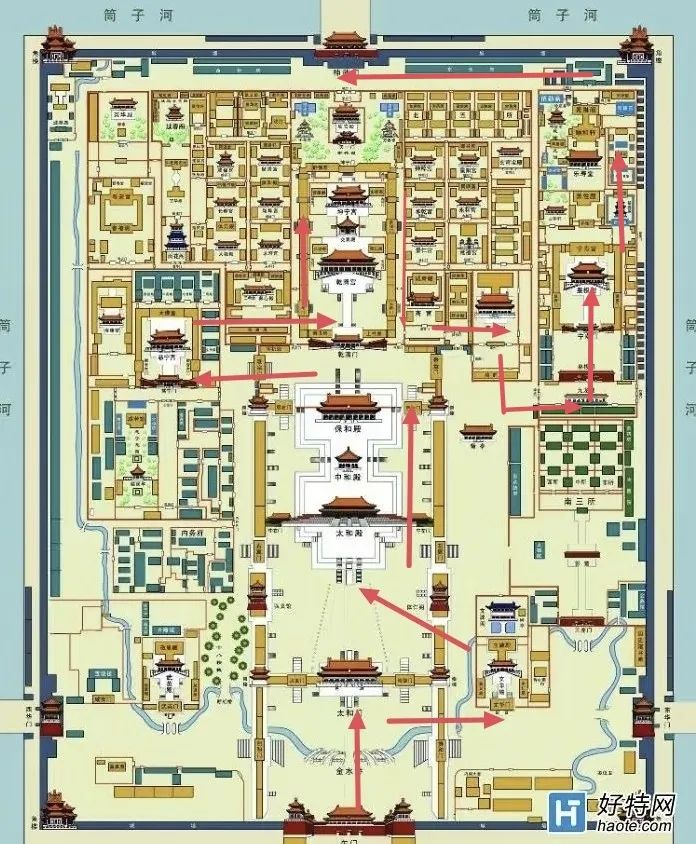
My tour route:
Tiananmen – Meridian Gate – Wenhui Palace (Painting and Calligraphy Gallery) – Three Great Halls (Hall of Supreme Harmony, Hall of Central Harmony, Hall of Preserving Harmony) – Palace of Compassion and Tranquility (Sculpture Gallery) – Hall of Clocks and Watches – Treasure Gallery (including Stone Drum Gallery) – Zhen Fei’s Well – Gate of Divine Prowess (Shenwumen)
People at different stages of life may have different interests in the Palace Museum. This was my third visit, and this time I focused on the characteristics of the ancient architecture and the exhibitions in the Palace Museum.
After passing the security check at the Meridian Gate, you have officially entered the Palace Museum.
The Meridian Gate is the largest gate in the Palace Museum, and there are several temporary exhibitions held here every year. By booking a visit to the temporary exhibition at the Meridian Gate, you can access the gate tower. Unfortunately, we couldn’t book the tea culture exhibition that was on display at the time.
Tip: When booking your Palace Museum visit, you can simultaneously book the temporary exhibition at the Meridian Gate.
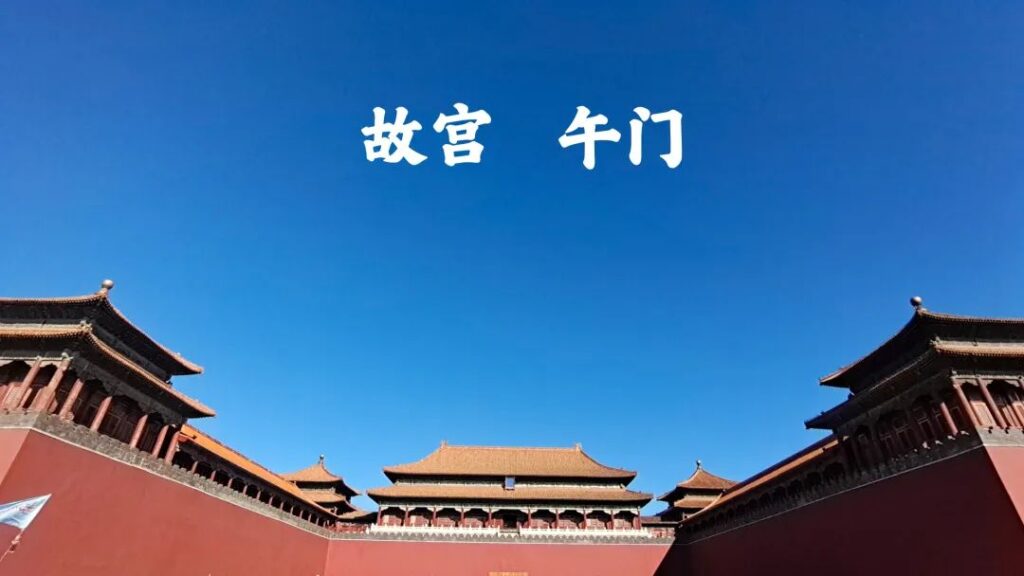
Entering through the central gate of the Meridian Gate, which was once reserved for the emperor, you will see the Gate of Supreme Harmony (Taihe Gate).

The central main building of the Meridian Gate features a double-eaved hip-and-gable roof, which was the highest-ranking architectural style in ancient times, second only to the Hall of Supreme Harmony in the Palace Museum. (The number of roof decorations is one less.)
Looking at the back of the Meridian Gate, there are five arched openings, but only three are visible from the front, following the “three visible, five hidden” layout.
The Golden Water Bridge, with the longest and widest central path, was used by the emperor, so of course, we should walk in the middle.
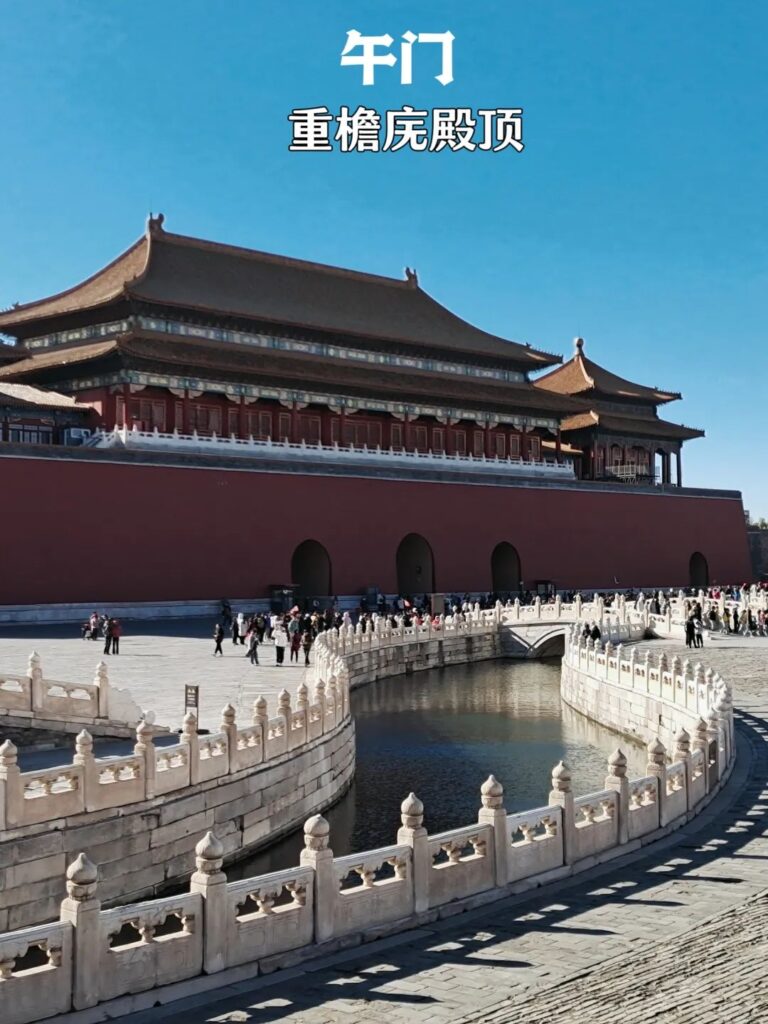
The Gate of Supreme Harmony features a double-eaved hip roof, which is lower in rank compared to the Meridian Gate.
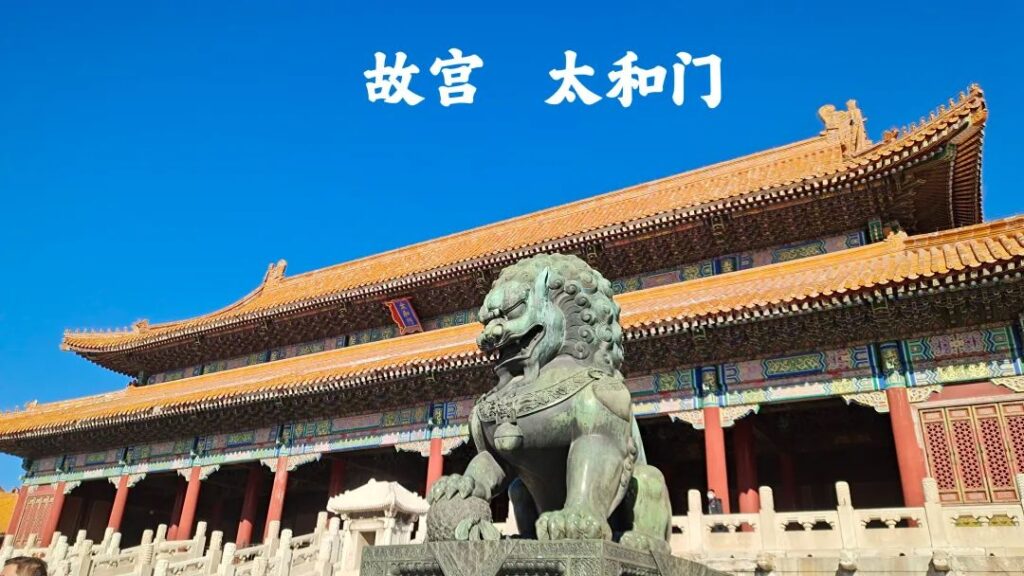
TIPS: The elevated platform on the side of the Gate of Supreme Harmony leading to the Wenhui Palace is a good spot for taking photos. You can use a large aperture to avoid the crowds and capture both the Meridian Gate and the Gate of Supreme Harmony.
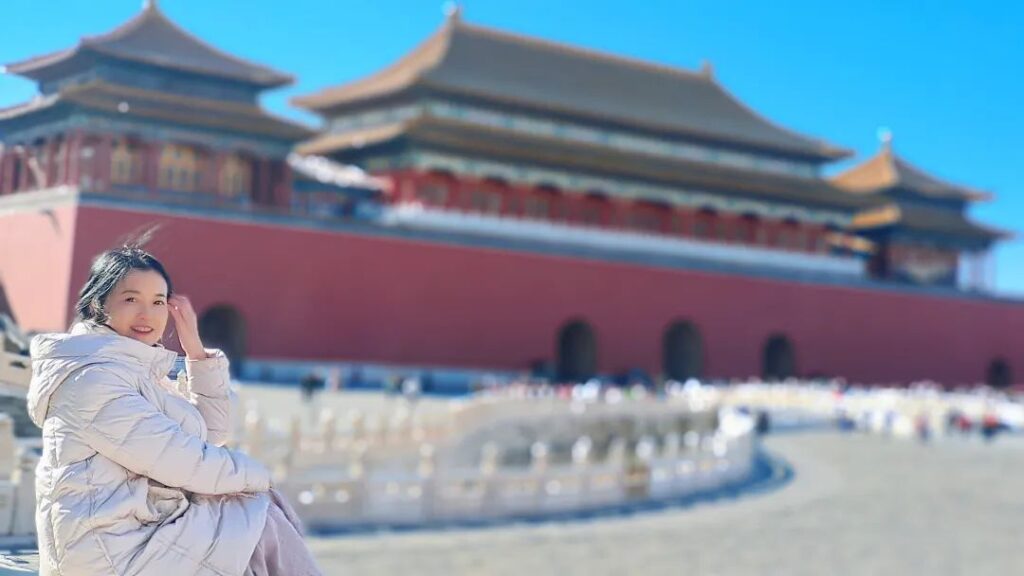
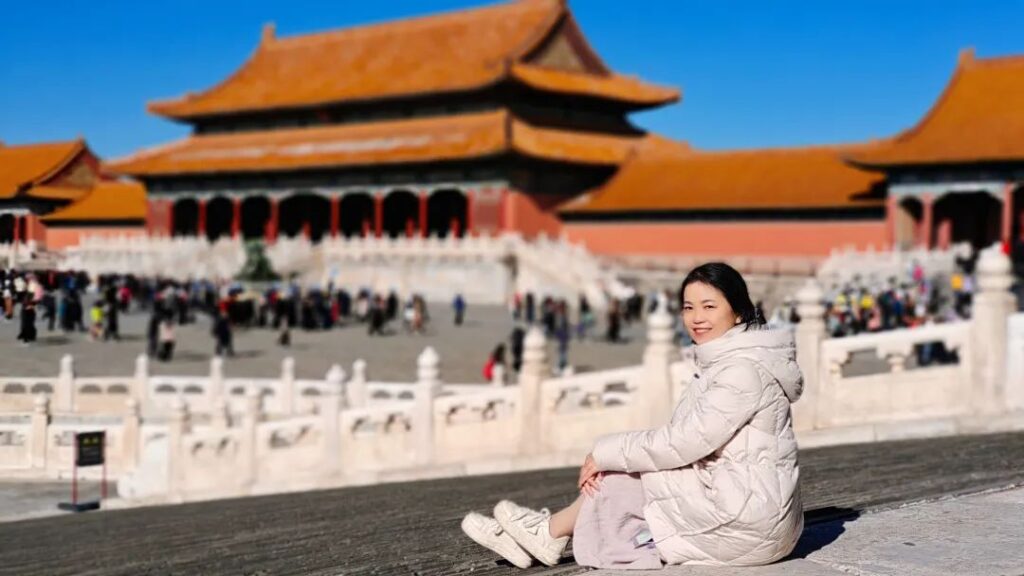
Wenhui Palace: During the Ming Dynasty, it was the place where the crown prince observed governance. In the Qing Dynasty, it was used for holding lectures. Now it serves as the painting and calligraphy gallery of the Palace Museum, which was our first desired exhibition hall. Unfortunately, it was closed due to the removal of the previous exhibition, leaving us with regret! It seems we’ll have to visit the Palace Museum again in the future!
Hall of Supreme Harmony: It is the largest palace in the Forbidden City, where ceremonies such as the emperor’s enthronement, birthday celebrations, grand weddings, and the crowning of the empress were held.
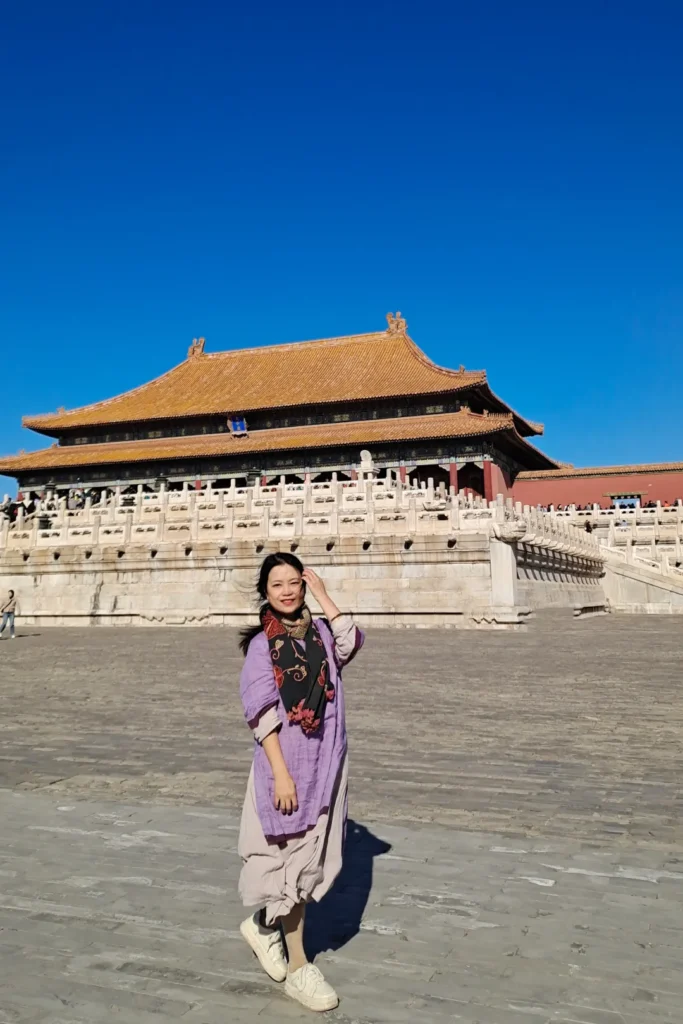
On the three-tiered steps, there are many “dragon heads” that create a spectacular sight of “thousands of dragons spitting water” when it rains.
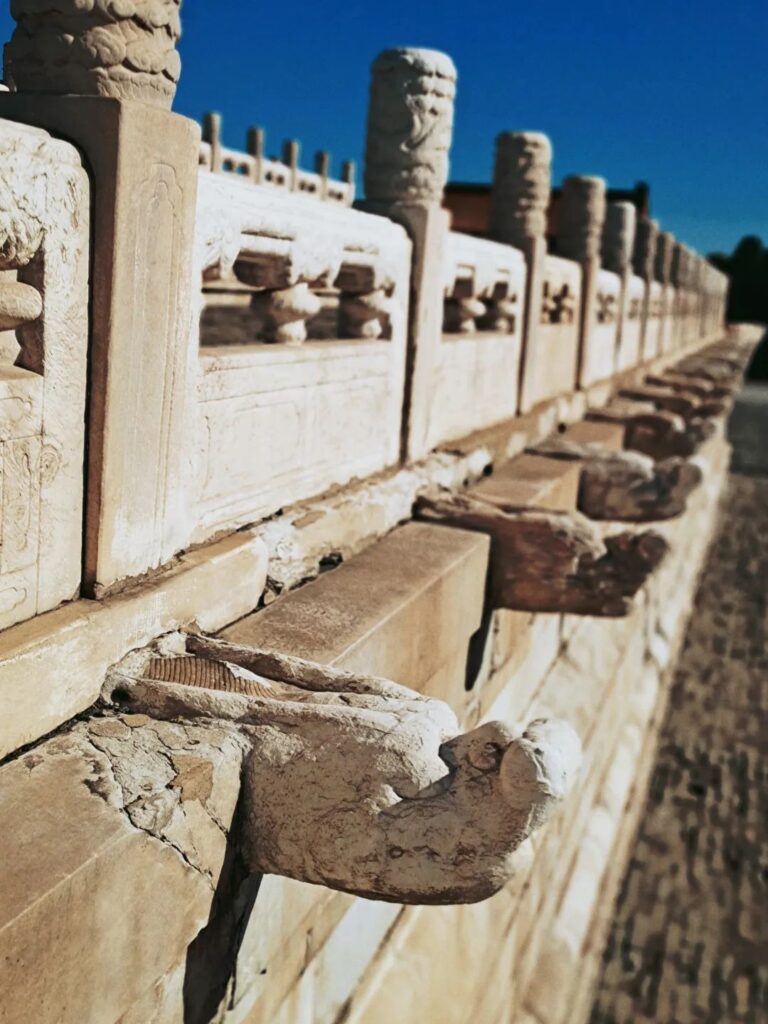
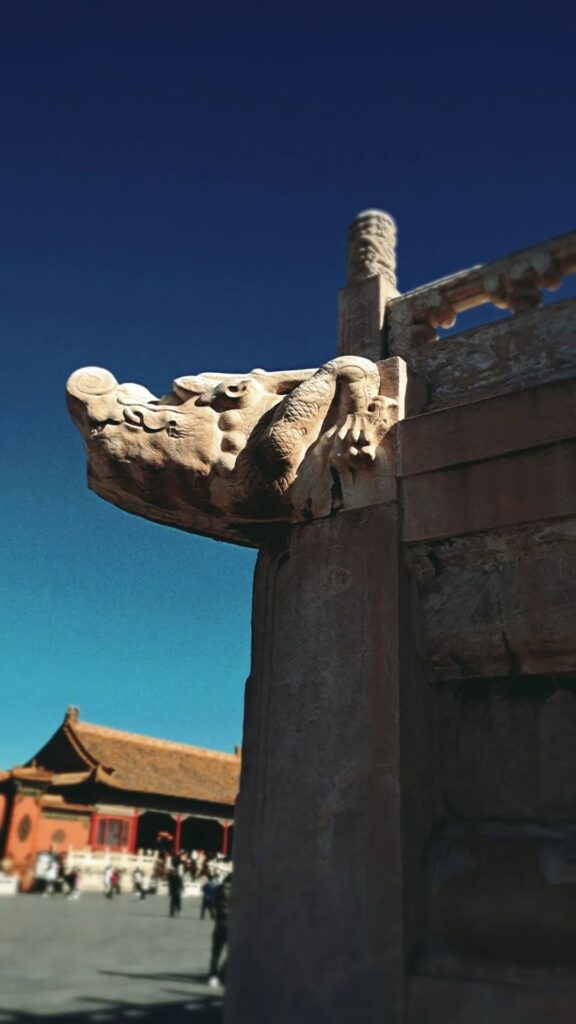
The Hall of Supreme Harmony has the highest architectural rank in the Palace Museum, with a double-eaved hip-and-gable roof.

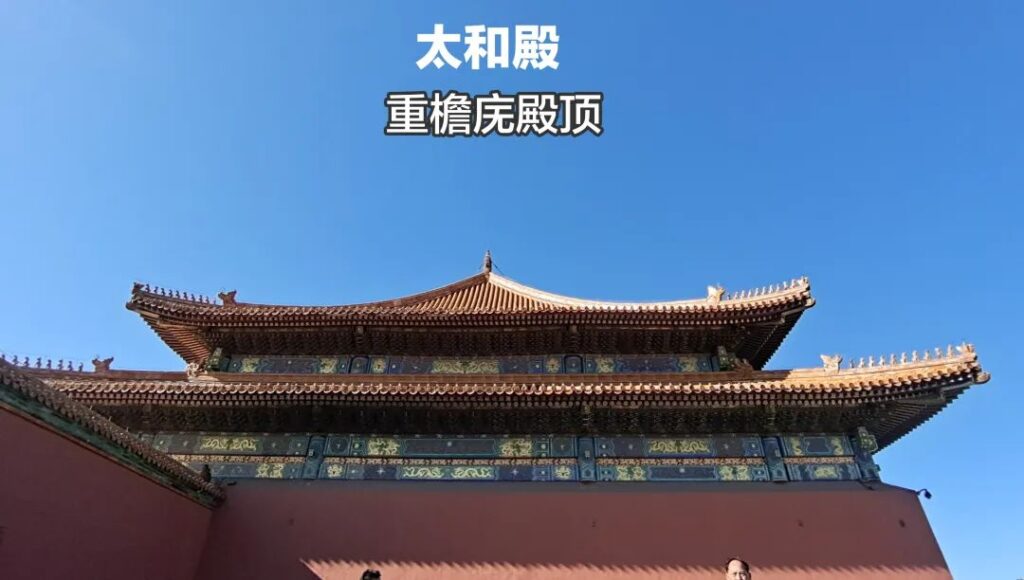
The number of roof decorations on the Hall of Supreme Harmony is ten, the highest architectural rank in ancient times.
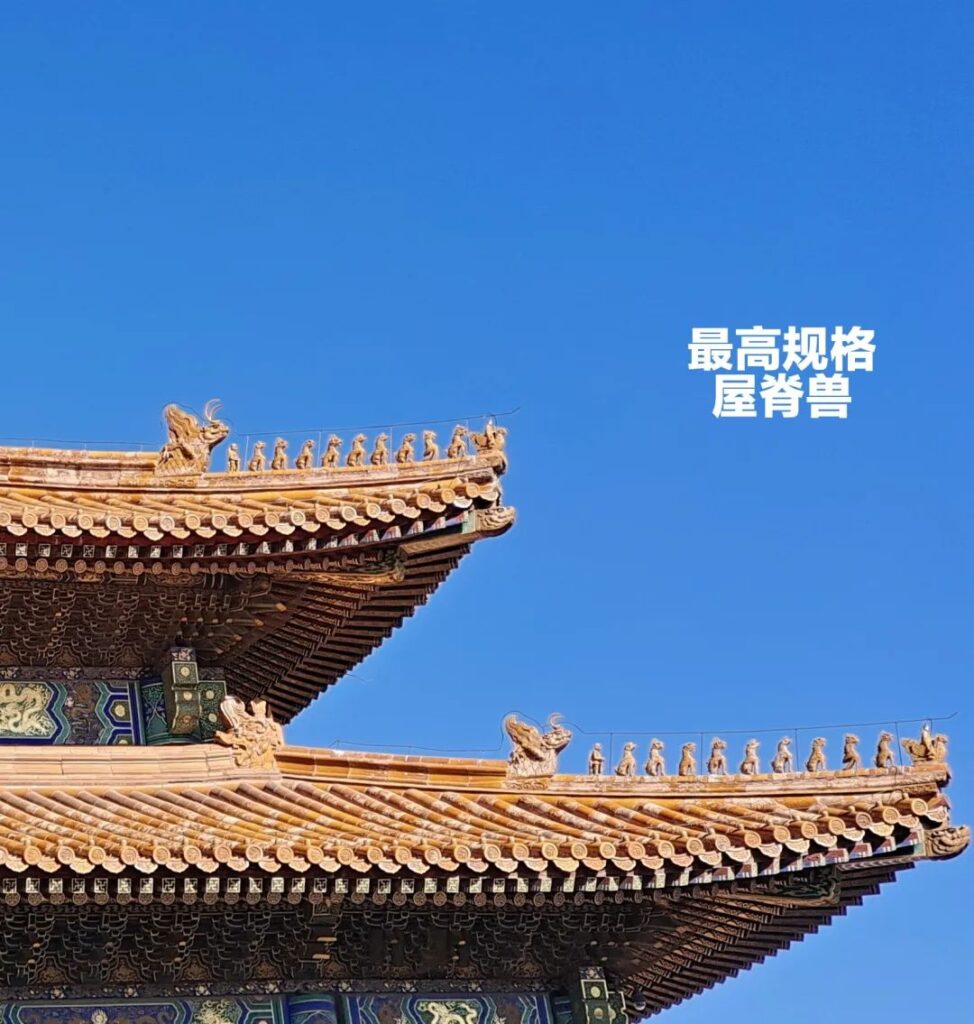
TIPS: While the front of the Hall of Supreme Harmony is crowded with people, the back is spacious and empty. The entire carved door at the back makes for a great photo spot.
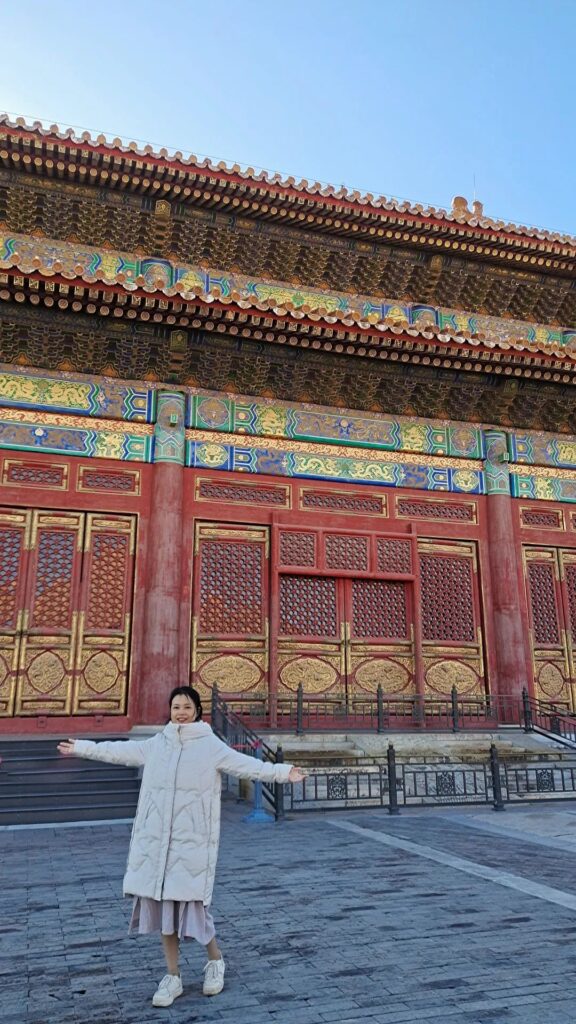
Hall of Central Harmony: It was the place where the emperor temporarily rested before attending grand ceremonies, reviewed memorials, and received kneeling salutes from the cabinet ministers.
The Hall of Central Harmony is square in shape, with a single-eaved pyramidal roof covered with yellow glazed tiles and a gilded bronze roof in the center.
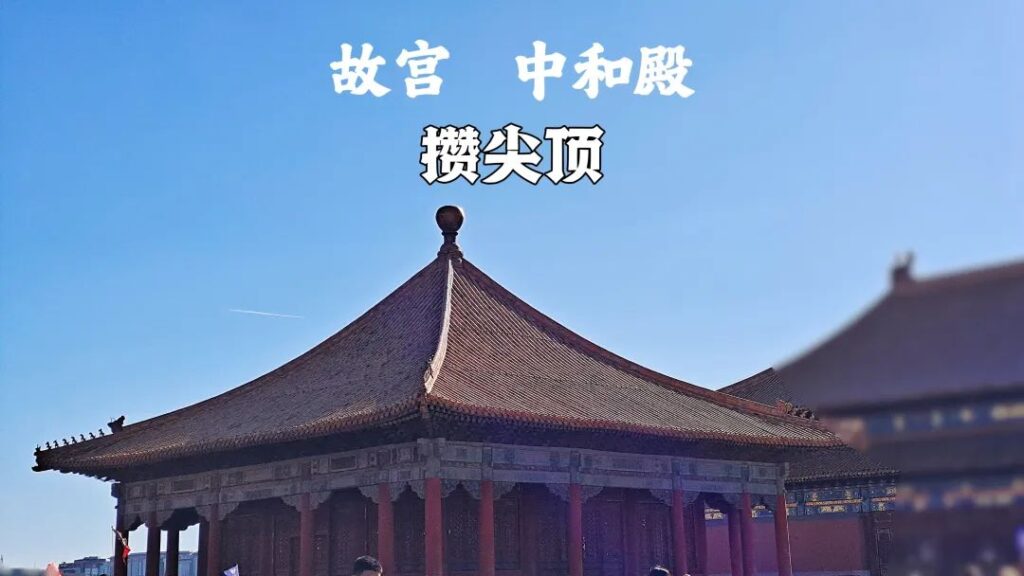

Hall of Preserving Harmony: During the Qing Dynasty, banquets and palace examinations were often held in the Hall of Preserving Harmony.

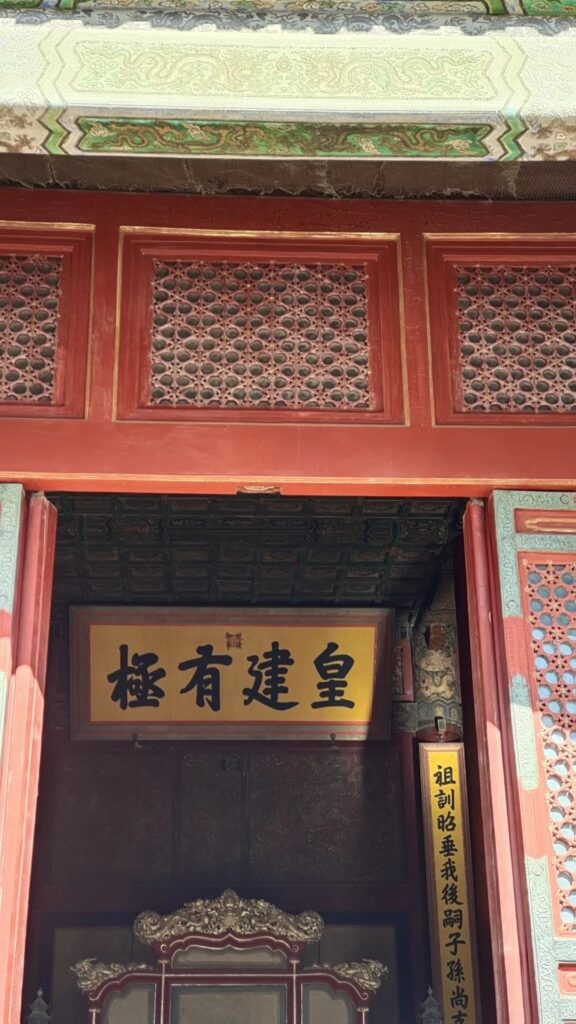
The Three Great Halls are crowded with people, and entry is not allowed. You can only observe the exterior, so it is recommended to pass through this part quickly, as the collections in the later exhibition halls are too rich to miss!
After visiting the Three Great Halls, we left the central axis and headed to the nearby palaces.
Palace of Compassion and Tranquility: During the Ming and Qing Dynasties, it was the residence of the Empress Dowager and the concubines of previous emperors. It also serves as the sculpture gallery, which I was particularly eager to visit.
The door signs here feature both Chinese and Manchu characters. The auspicious beasts at the entrance are golden Qilin (a mythical creature).
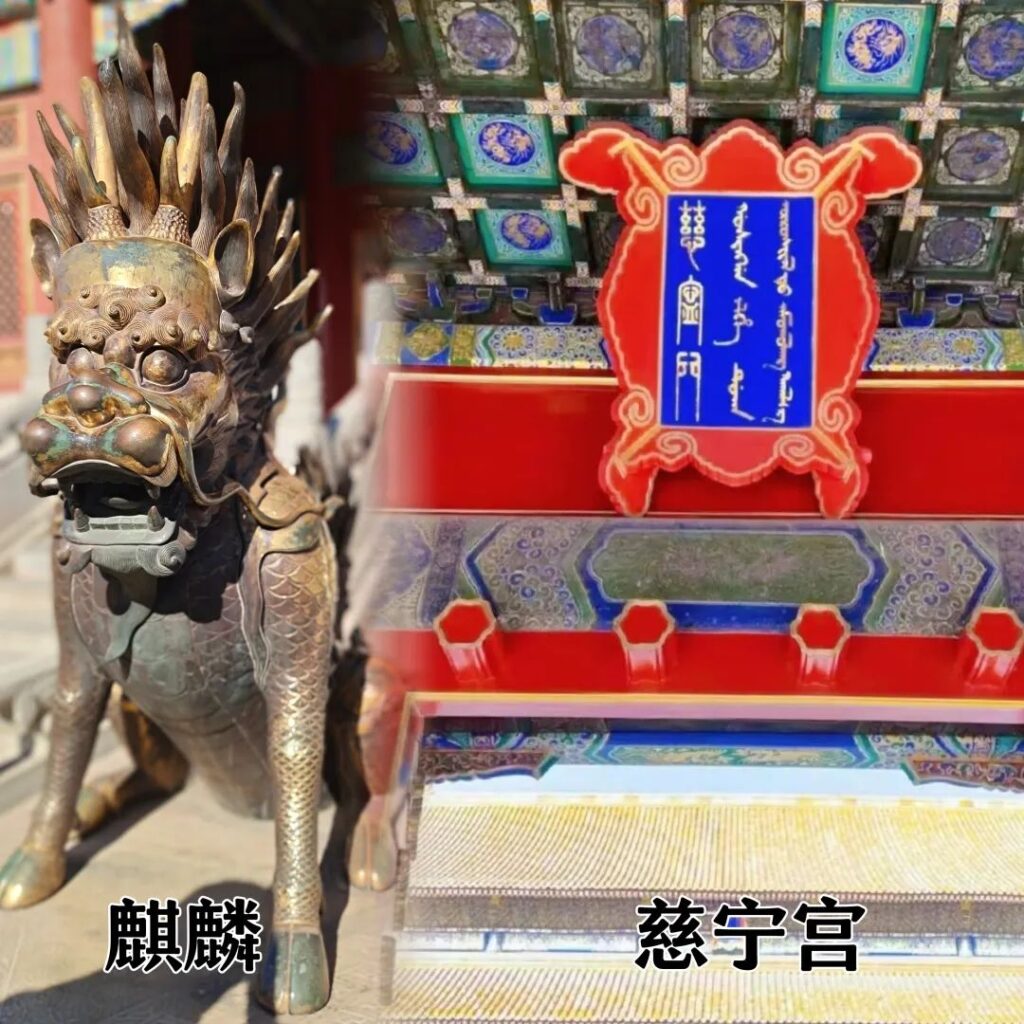
On display are various artistic sculptures made of wood, stone, metal, bone, horn, and ivory, mainly featuring Buddhist statues from different historical periods, each with its unique characteristics. It was a feast for the eyes!
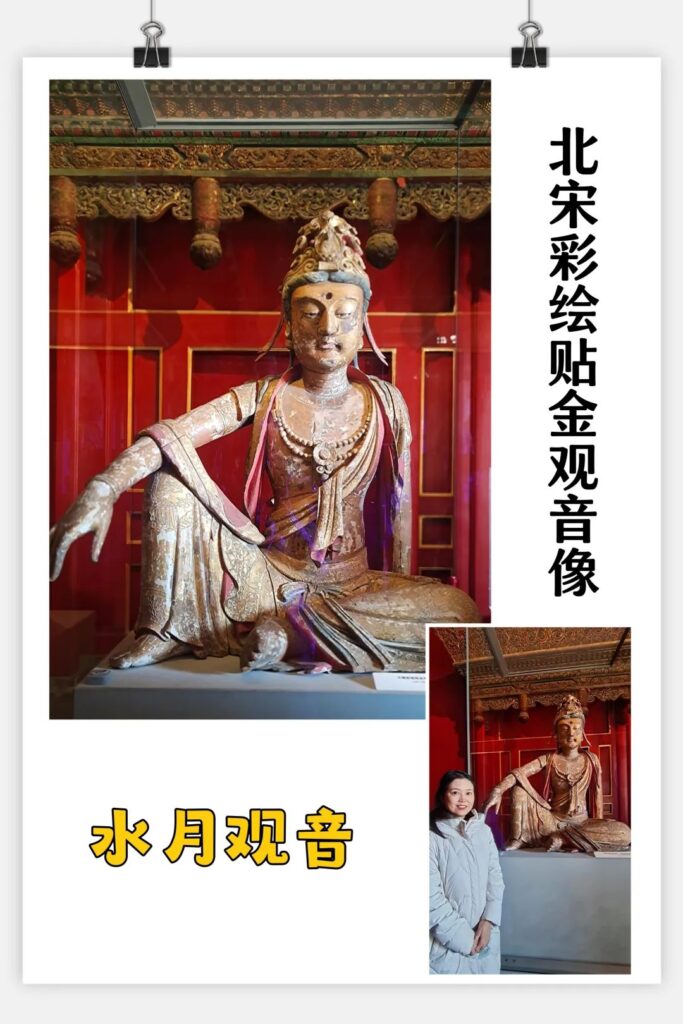
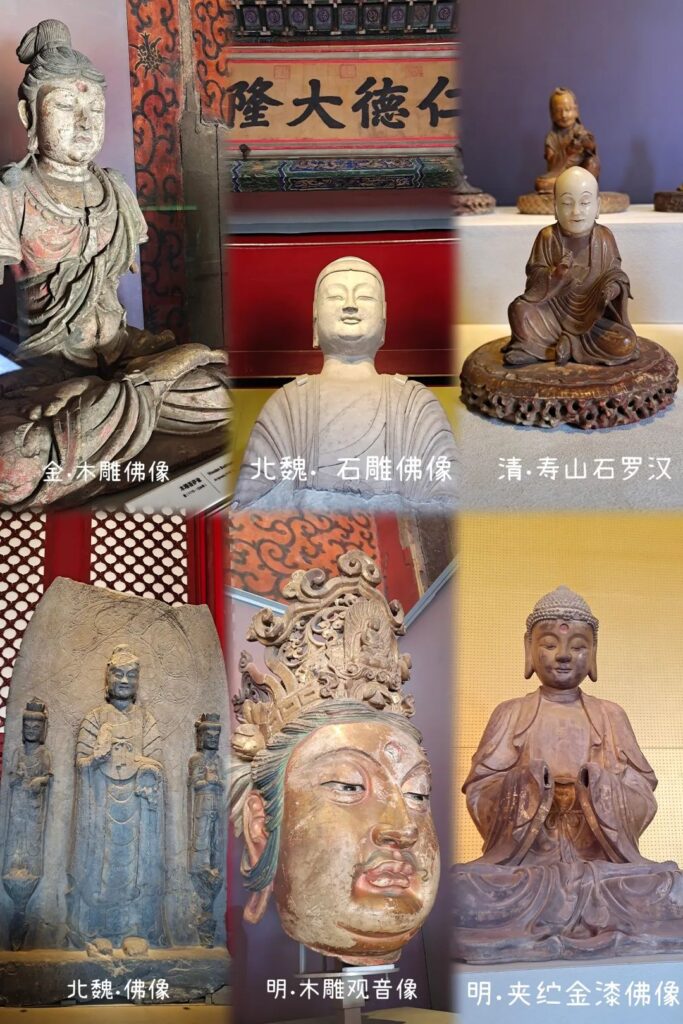
The famous Eastern Han stone sculpture of a man and woman embracing, which I had long heard of, was finally seen in person. This extremely bold and lifelike carving from two thousand years ago was unearthed from a tomb in Sichuan.
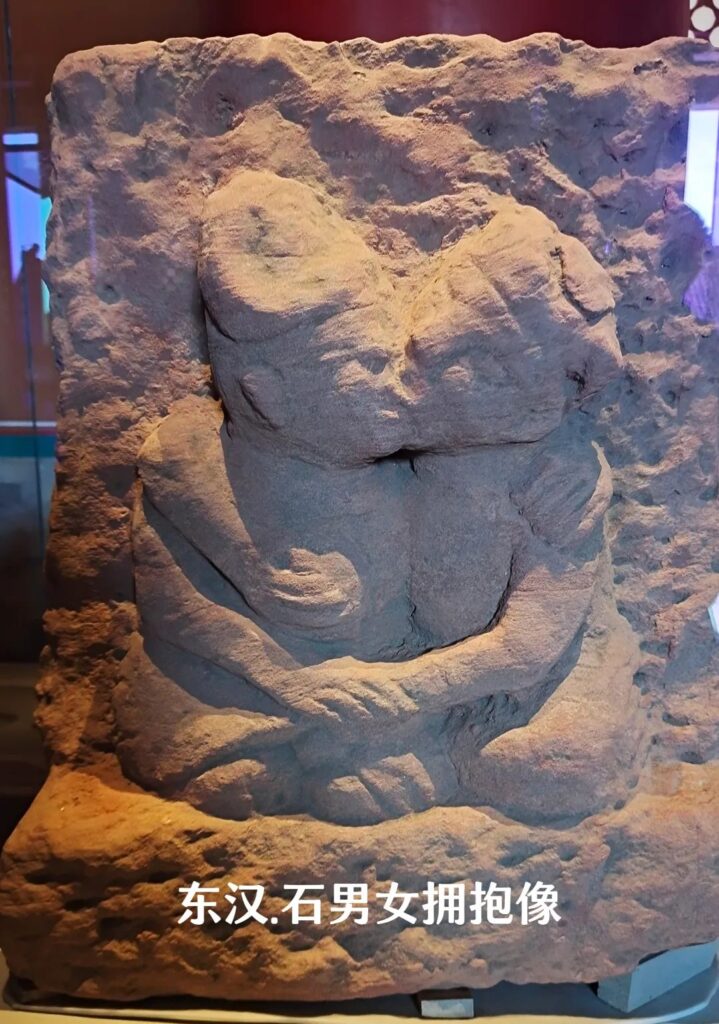
The realistic sculpture of Bodhidharma, with each rib protruding and a skeletal appearance, is full of artistic appeal!
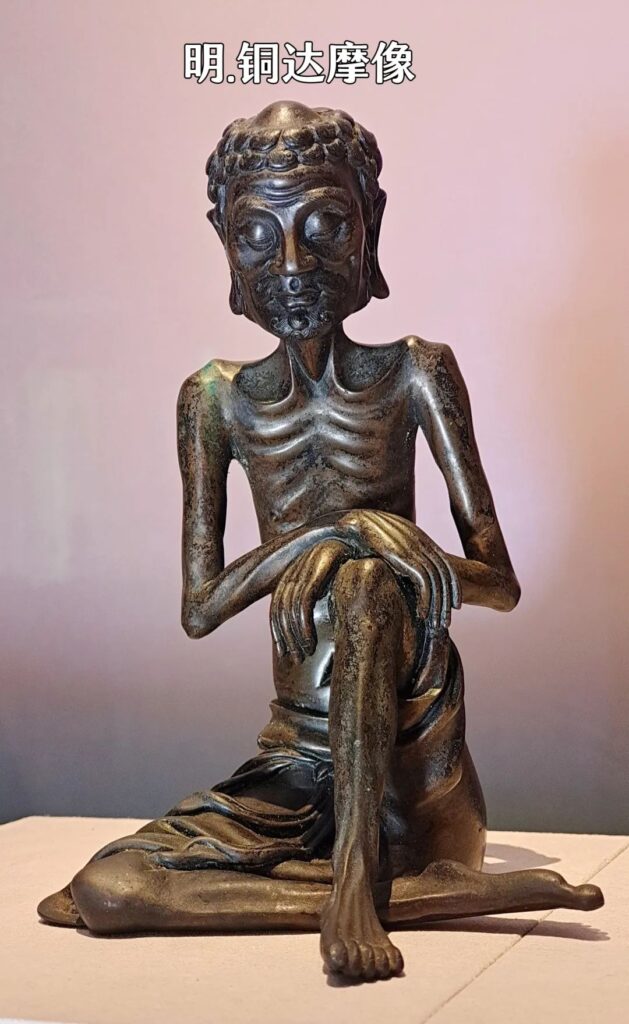
Afterward, we returned to the central axis and continued to explore the three great halls in the rear half of the Palace Museum.
Palace of Heavenly Purity: Until the reign of Emperor Kangxi, it served as the emperor’s bedchamber. After Emperor Yongzheng moved the bedchamber to the Hall of Mental Cultivation, this palace became the place where the emperor summoned court officials, reviewed memorials, and handled daily political affairs.
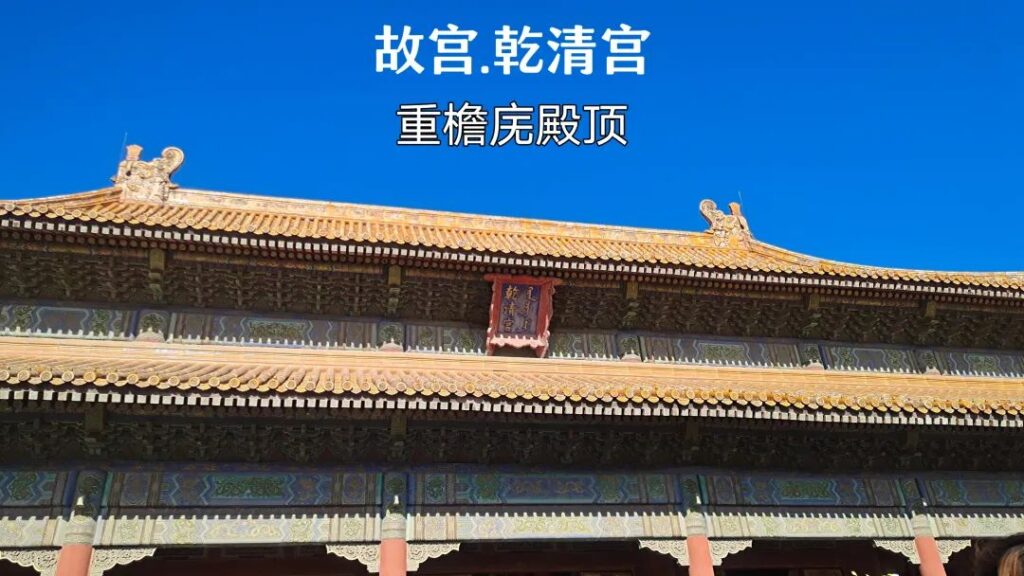
Behind the “Upright and Bright” plaque in the Palace of Heavenly Purity is the secret storage area for the Qing Dynasty’s Yongzheng Emperor’s “building reserve” boxes.

Hall of Union: A square hall with a pyramidal roof, where the ceremonies for crowning the empress and celebrating her birthday were held during the Ming and Qing Dynasties. The carved doors are intricately beautiful!
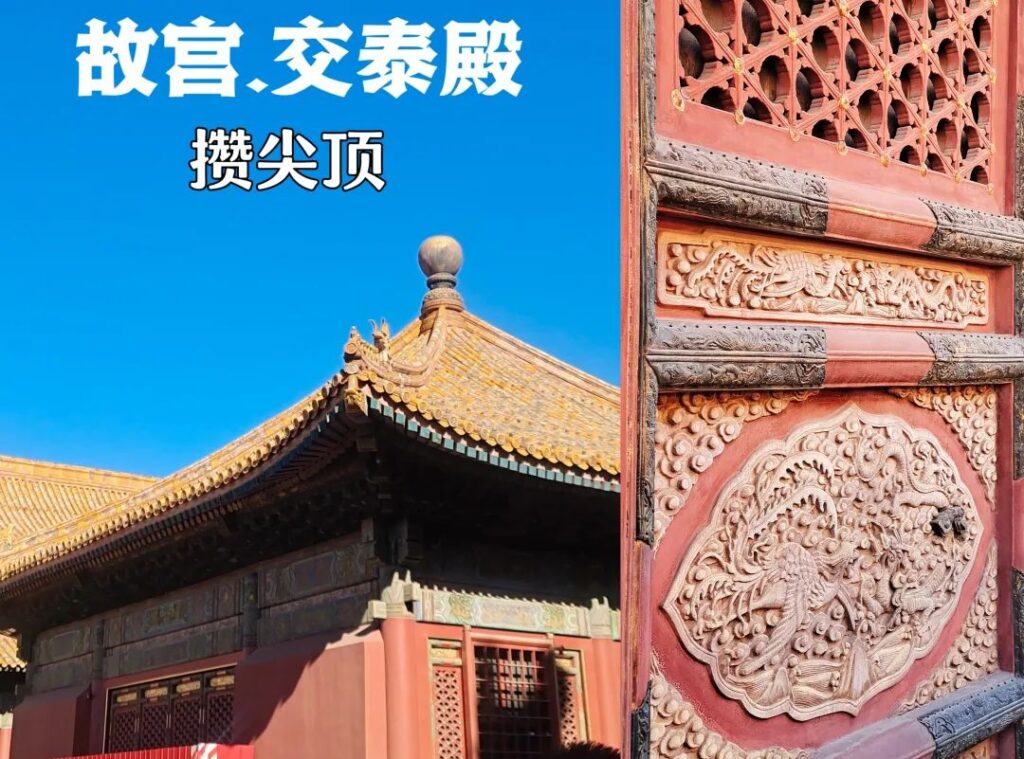
Although entry is not allowed, you can get close to the hall’s door and see Emperor Kangxi’s “Wuwei” plaque in his handwriting and the exquisite caisson ceiling.

Palace of Earthly Tranquility: The residence of the empress. It also houses the Palace Museum’s exhibition of traditional Chinese medicine culture. Fans of traditional Chinese medicine should take a closer look at the essence of our traditional medical culture.


After visiting these three great halls, we began our search for the Hall of Clocks and Watches and the Treasure Gallery. Along the way, we passed by many small palaces, far too many to explore them all. However, I recommend visiting the Palace of Prolonging Happiness.
The Palace of Prolonging Happiness was the residence of concubines during the Ming and Qing Dynasties. With red walls, yellow leaves, and green glazed tiles, the courtyard is filled with persimmon trees, creating a strong palace atmosphere.
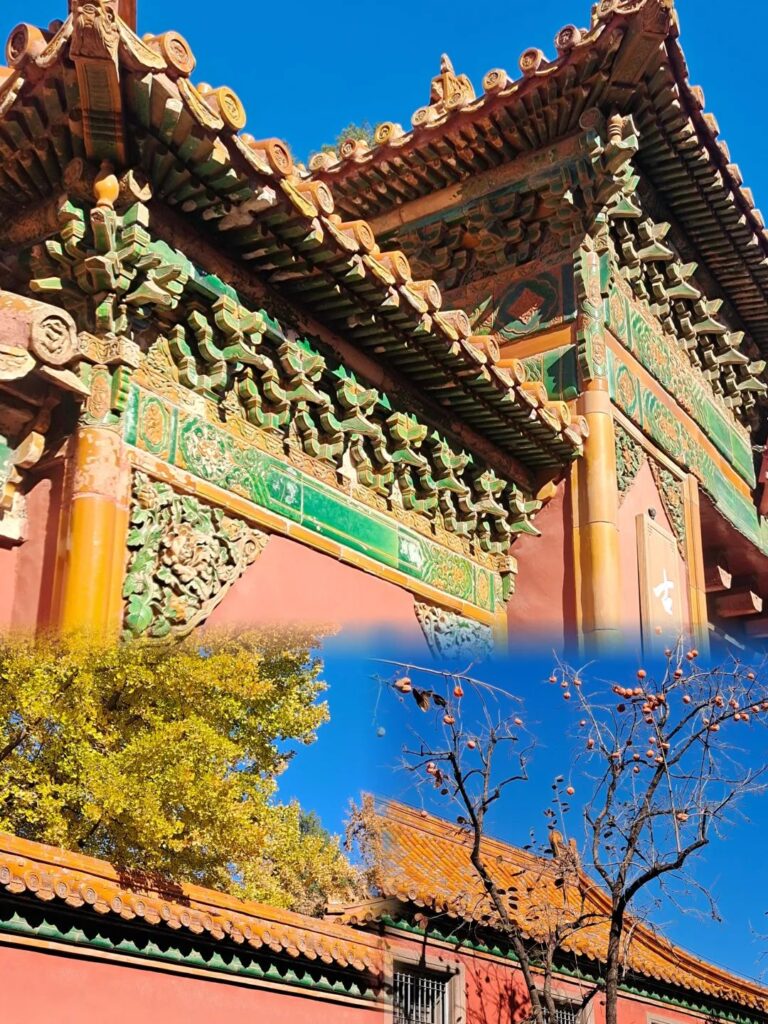
In 1845, the Palace of Prolonging Happiness was destroyed by a fire. It was rebuilt as a three-story Western-style building with a steel frame called the Lingzhao Pavilion (commonly known as the Crystal Palace). However, due to the emptiness of the national treasury, the construction was never completed, making it the only unfinished project in the Palace Museum.
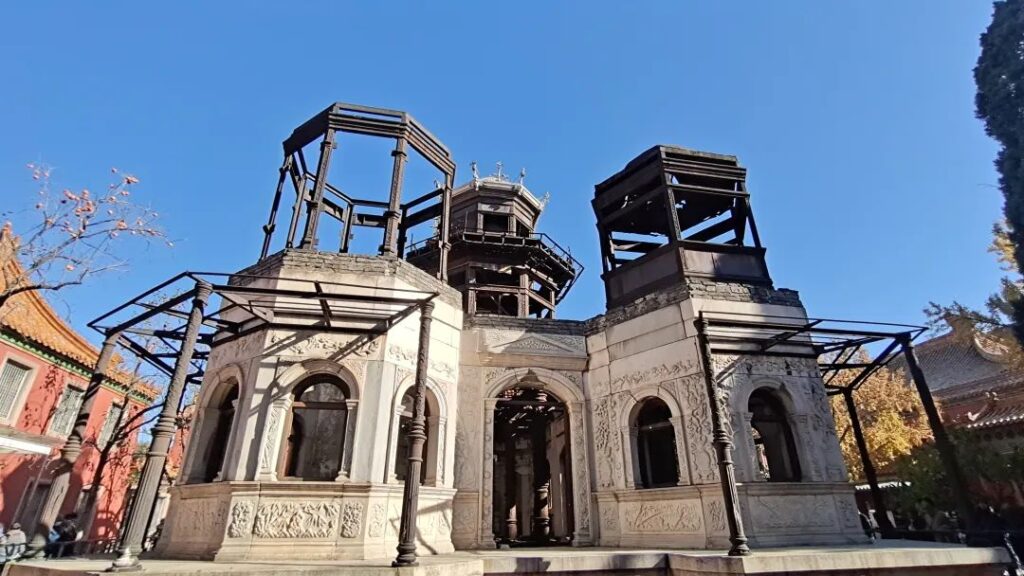
The Hall of Clocks and Watches and the Treasure Gallery require an additional fee on top of the Palace Museum entrance ticket. The ticket costs 10 yuan (5 yuan for the elderly) and can be purchased together with the entrance ticket on the official website or on-site by scanning a QR code. Both halls display the palace’s precious collections and are well worth the price. They are a must-see.
The Hall of Clocks and Watches is located in the Hall of Ancestral Worship. There are numerous exquisite clocks from England, France, and Switzerland, as well as those made by the Qing Palace Workshop. These clocks are adorned with various gems and pearls, showcasing intricate, complex, and luxurious craftsmanship!
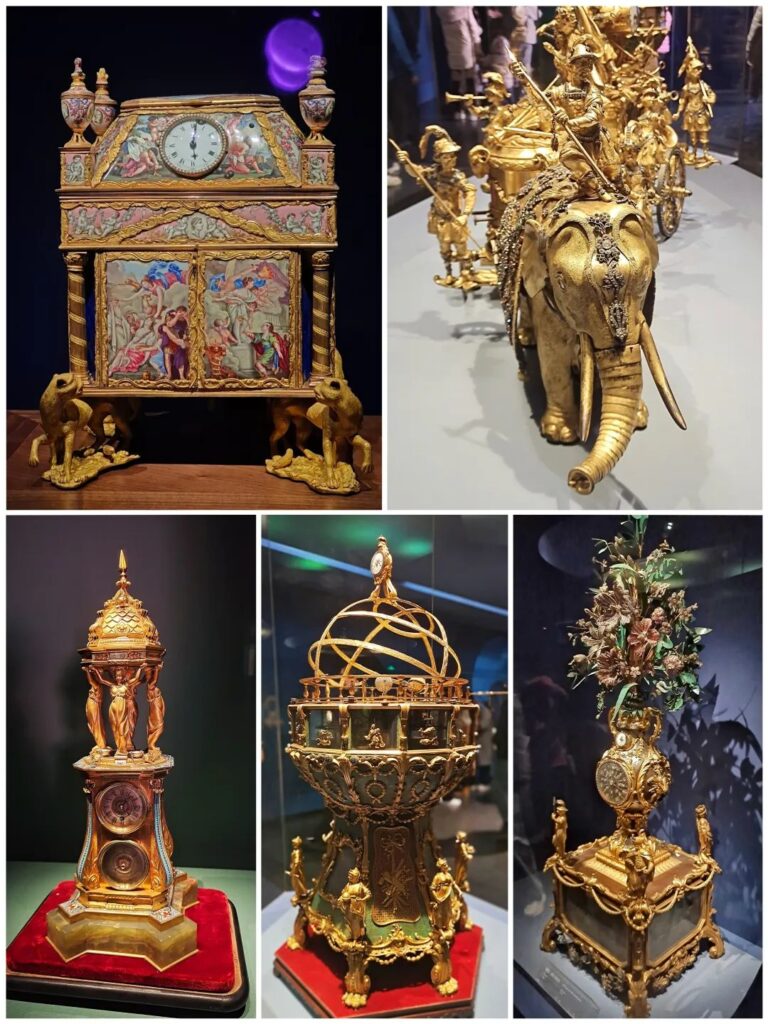
Every detail is captivating!
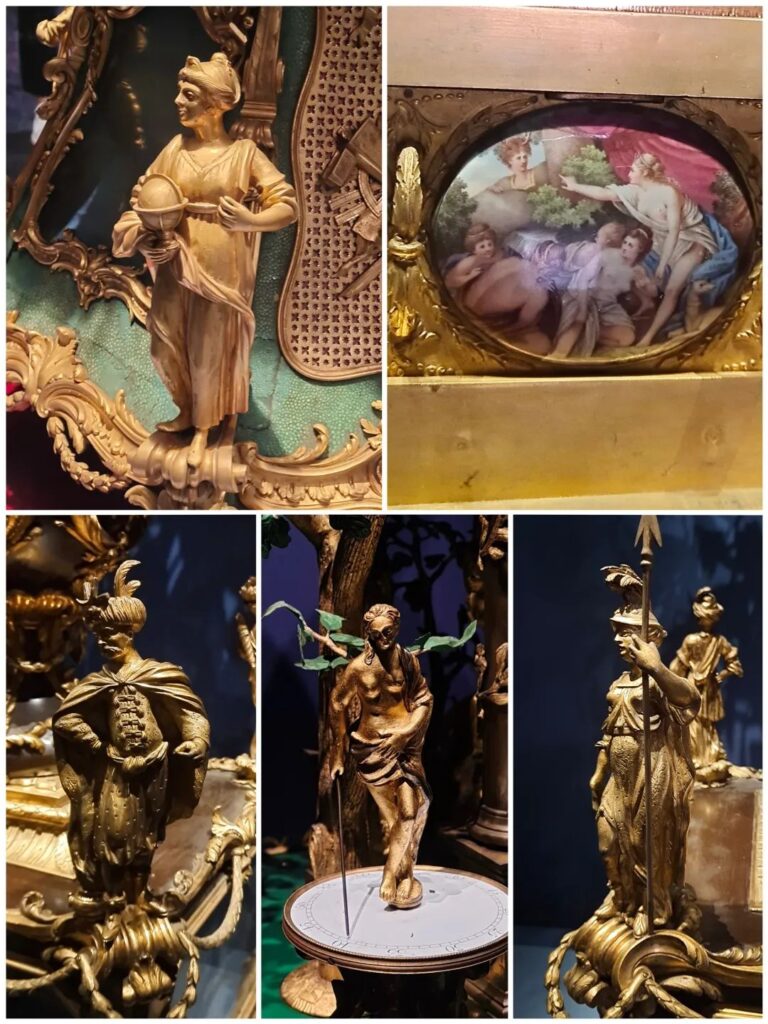
The most unforgettable piece is the copper-gilt writing clock from England, which has four tiers in total. The mechanical gentleman on the first tier can write eight Chinese characters, while the two figures on the top tier can unfurl a banner that reads “Longevity Without Limit.”
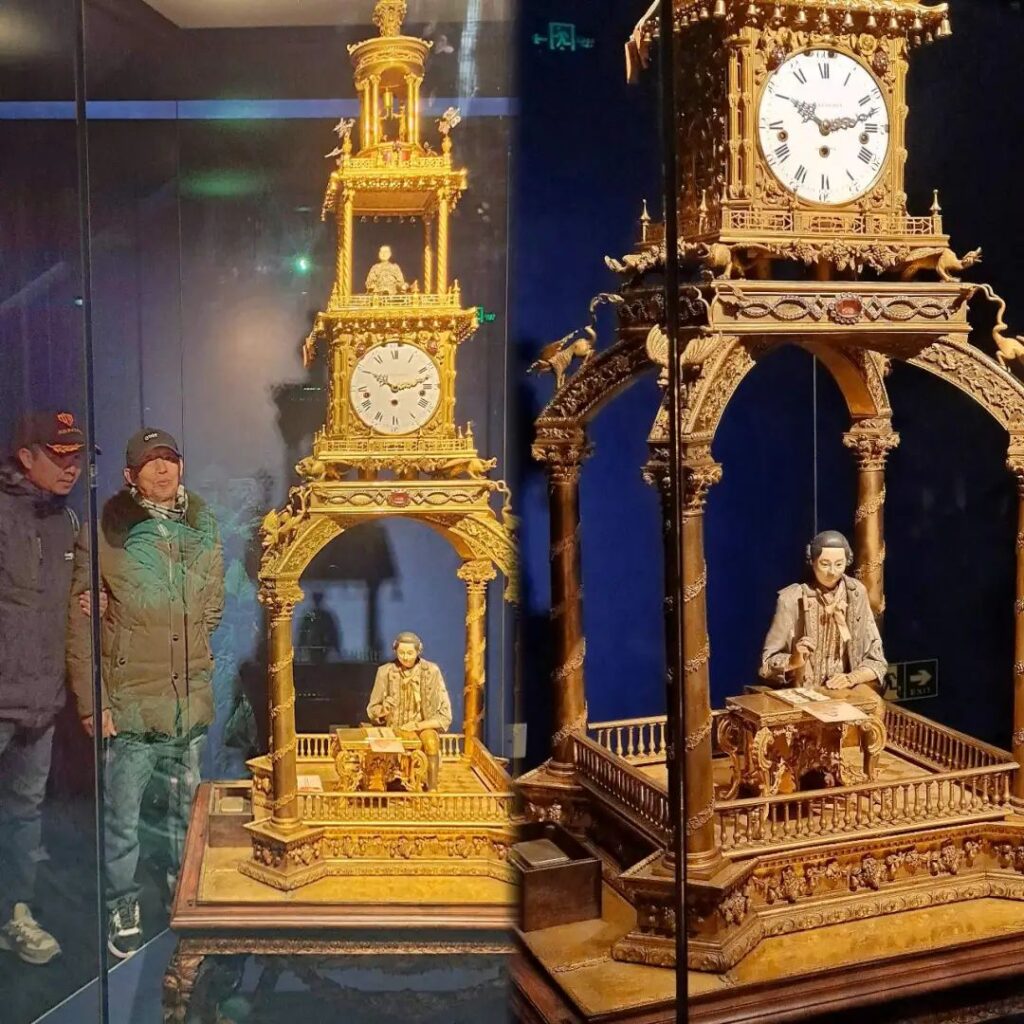
One of the Ten Treasures of the Palace Museum is the Pavilion-style Clock with Automatic Doors and Immortals Offering Birthday Congratulations, made by the Qing Palace Workshop. It features colored lacquer and gold outlining. Inside the clock, a bell-striking figure punctually reports the time, and various immortals gather in the pavilions, creating an extraordinarily lively scene. From design to completion, this clock took over five years, demonstrating a remarkably high level of technical skill.
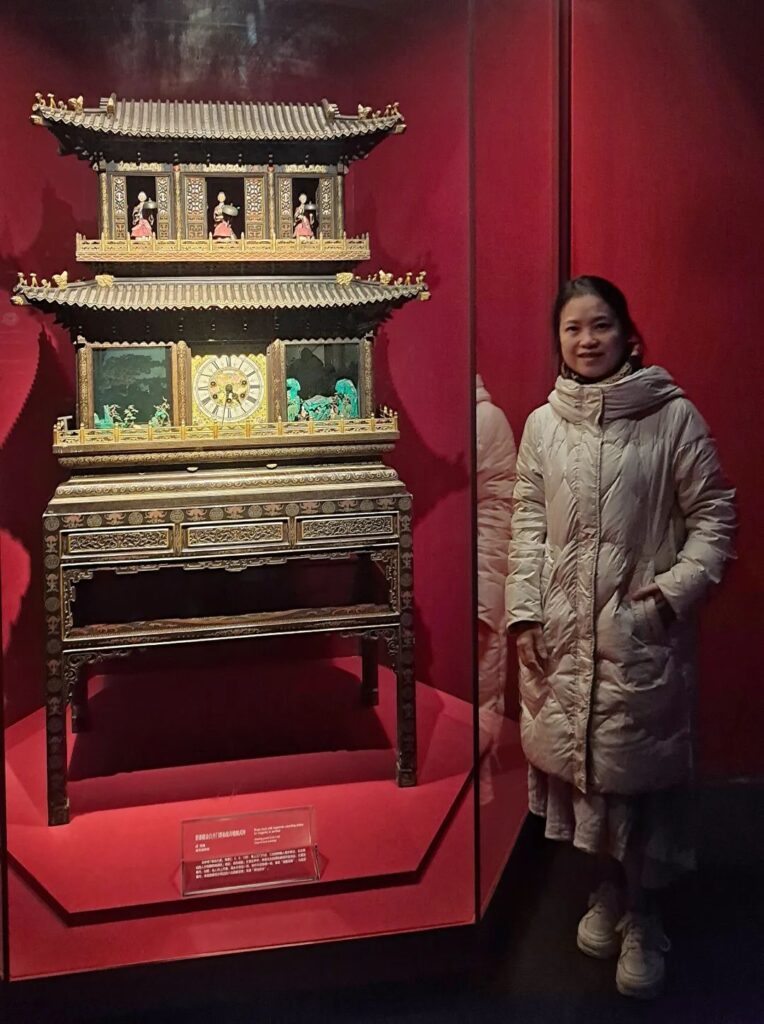
Treasure Gallery: Located in the Hall of Imperial Supremacy and the Palace of Tranquil Longevity, which were previously the residences of retired emperors.
The Nine-Dragon Wall in front of the entrance is quite famous. Take a photo with it.

The Hall of Imperial Supremacy primarily displays various treasures made from materials such as gold, silver, jade, emerald, and pearls. You can find anything you can imagine here.
Gemstone Bonsai: Flowers, plants, trees, and fruits made from gold, silver, gems, jadeite, coral, jade, and agate, paired with pots crafted from gold, silver, enamel, jade, carved lacquer, and inlaid materials, creating a delightful and complementary combination.
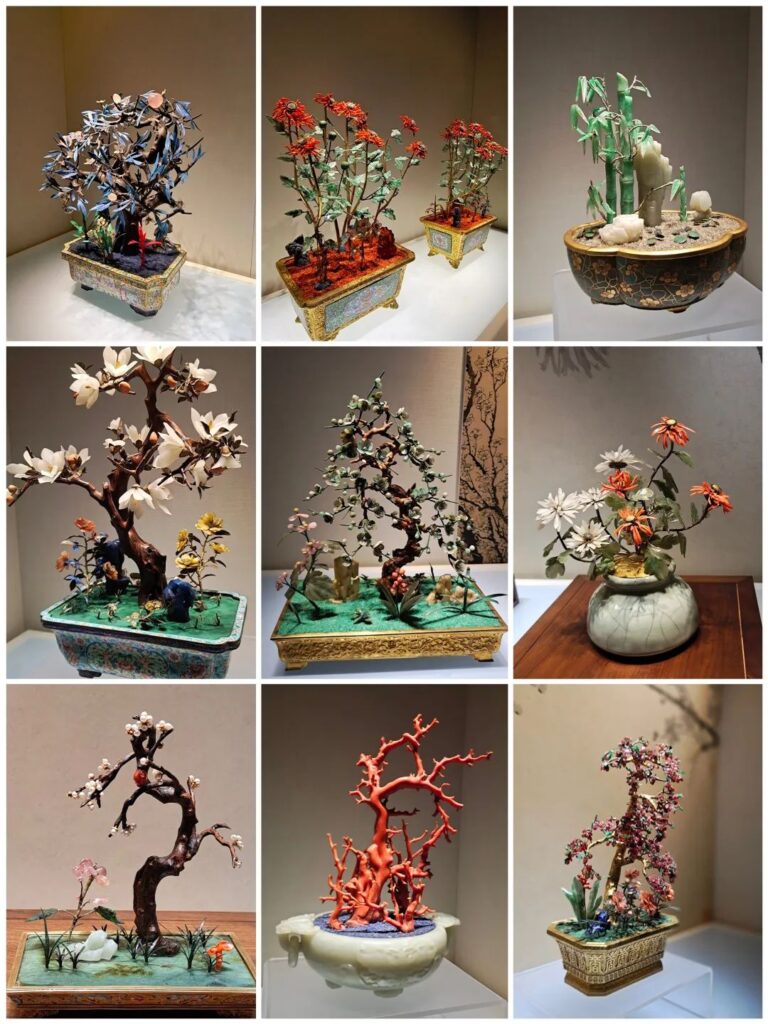
There are too many treasures to list them all.
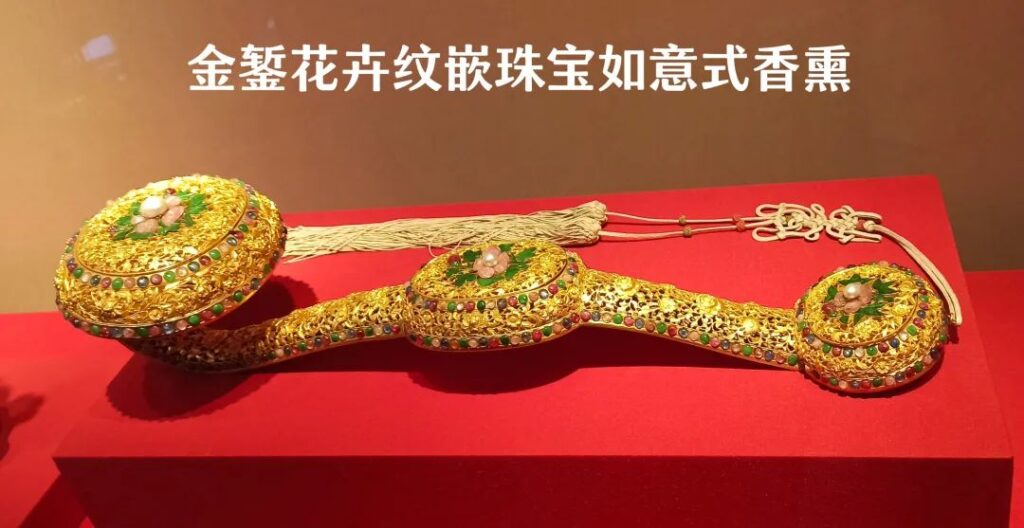
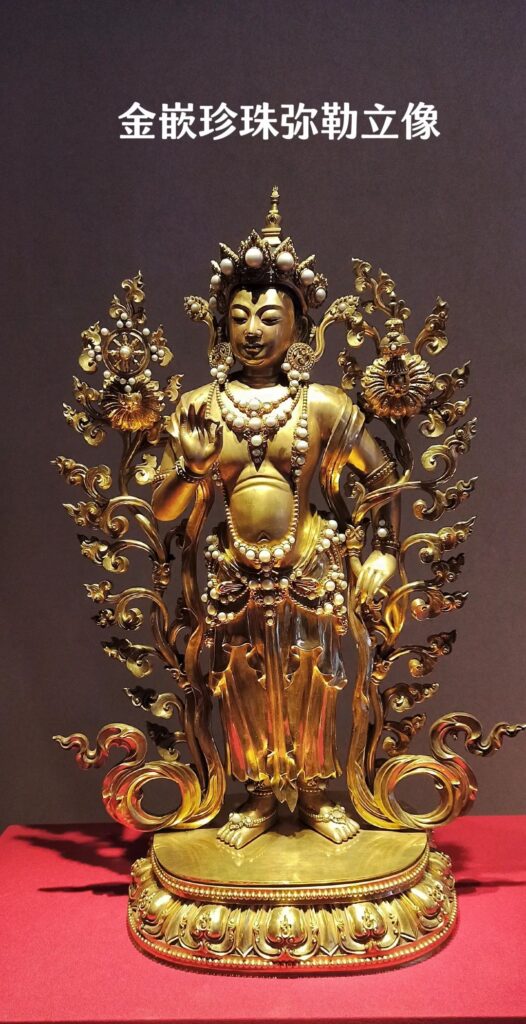
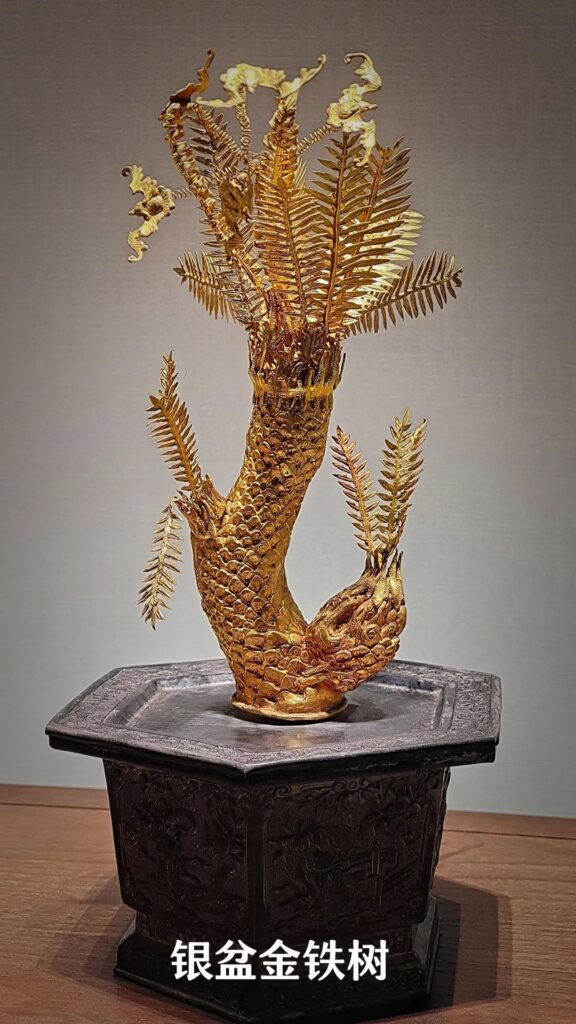
While the Hall of Imperial Supremacy is crowded with people, the Palace of Tranquil Longevity behind it is almost empty. This is where the “Stone Drums,” one of the Ten Treasures of the Palace Museum, is located, which is overlooked by most people. It is also one of the Nine Treasures of China, as featured in the January 2013 issue of “National Humanity History” magazine! It is a cultural relic that is forbidden from being exhibited abroad!
In 374 BC, the Qin State carved ten pieces of hard granite into drum shapes and engraved them with seal script characters. The Stone Drums are known as the “Ancestor of Stone Carvings.” The text describes a hunting and sacrificial activity of the Qin ruler during the Spring and Autumn period, with each stone drum containing a poem, totaling over 700 characters. The Stone Drums were discovered during the Tang Dynasty and preserved as important cultural relics. Emperor Huizong of the Song Dynasty once cherished them and filled the engravings with gold. The Jin people later took the Stone Drums away and abandoned them in the wilderness. They were later found again and experienced the turbulent times of the Yuan, Ming, and Qing dynasties. Today, ten Stone Drums remain, with over 300 characters still legible.
The calligraphy on the Stone Drums is ancient, simple, and beautifully unique. It has been regarded as an important model for practicing seal script by calligraphers throughout history. I hope that one day I will also have the opportunity to practice copying it.
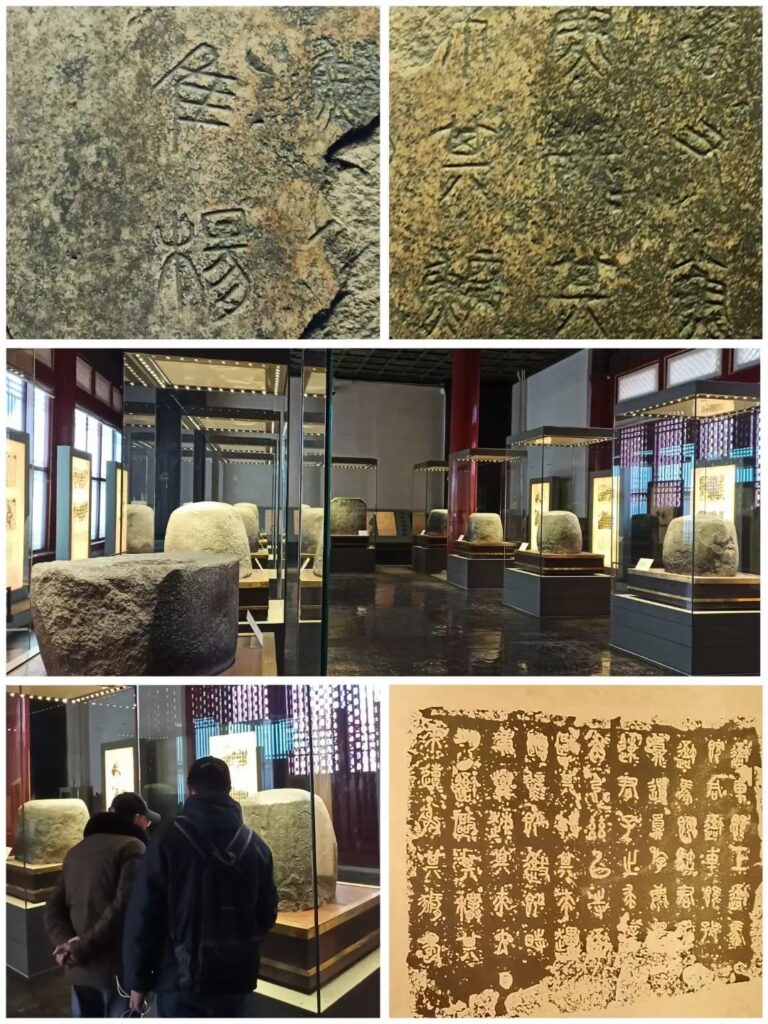
After visiting the Stone Drum Pavilion, we had completed all our plans for the Palace Museum, and our step count had exceeded 20,000. We felt exhausted. From the Well of Concubine Zhen, we made our way to the Gate of Divine Prowess and bid farewell to the Palace Museum.
Across the street from the Gate of Divine Prowess is Jingshan Park. Climbing Jingshan Hill offers a panoramic view of the Palace Museum and even the area within the Second Ring Road of Beijing. Watching the sunset from there is also very beautiful. Although we had pre-booked tickets, we gave up on visiting due to the strong winds that day.
After leaving the Palace Museum, we walked along the moat and saw the corner towers, which possessed a tranquil beauty.


